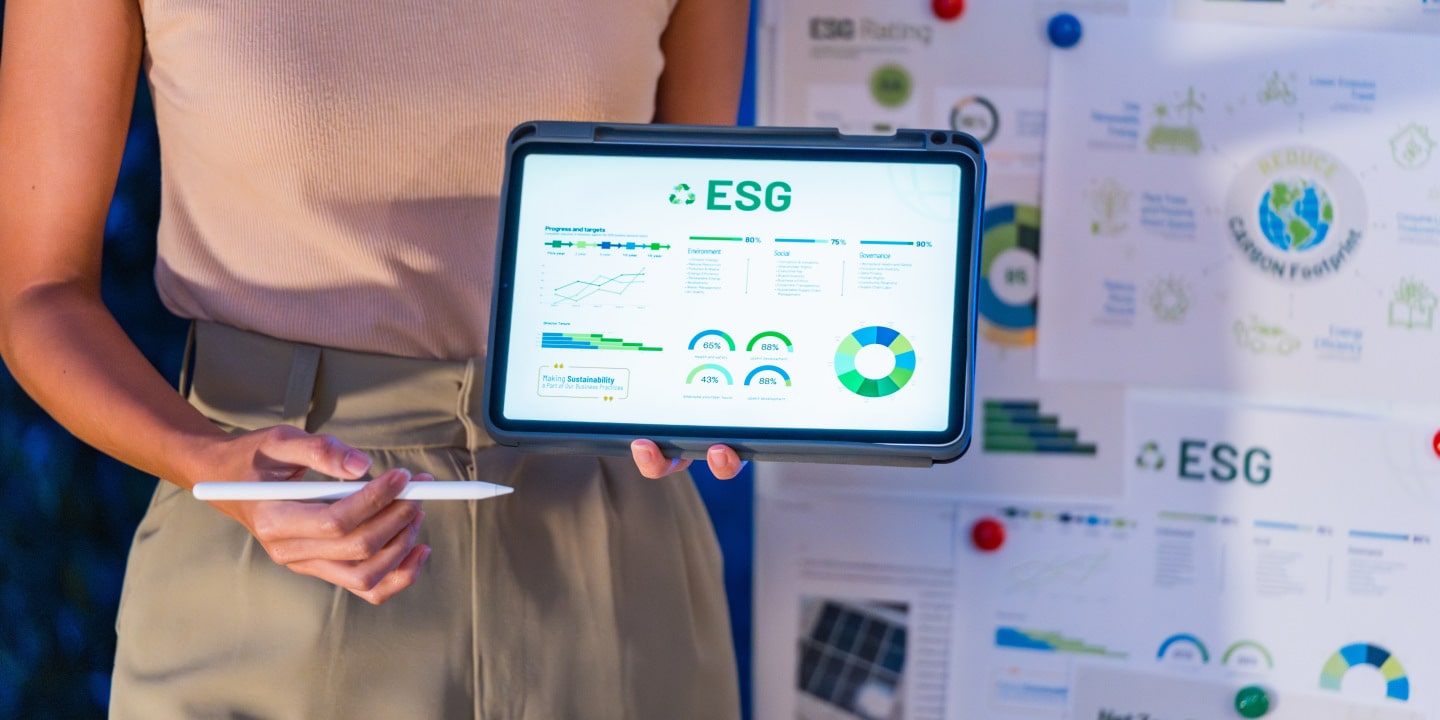The Essential Guide to Renewable Energy Software Development
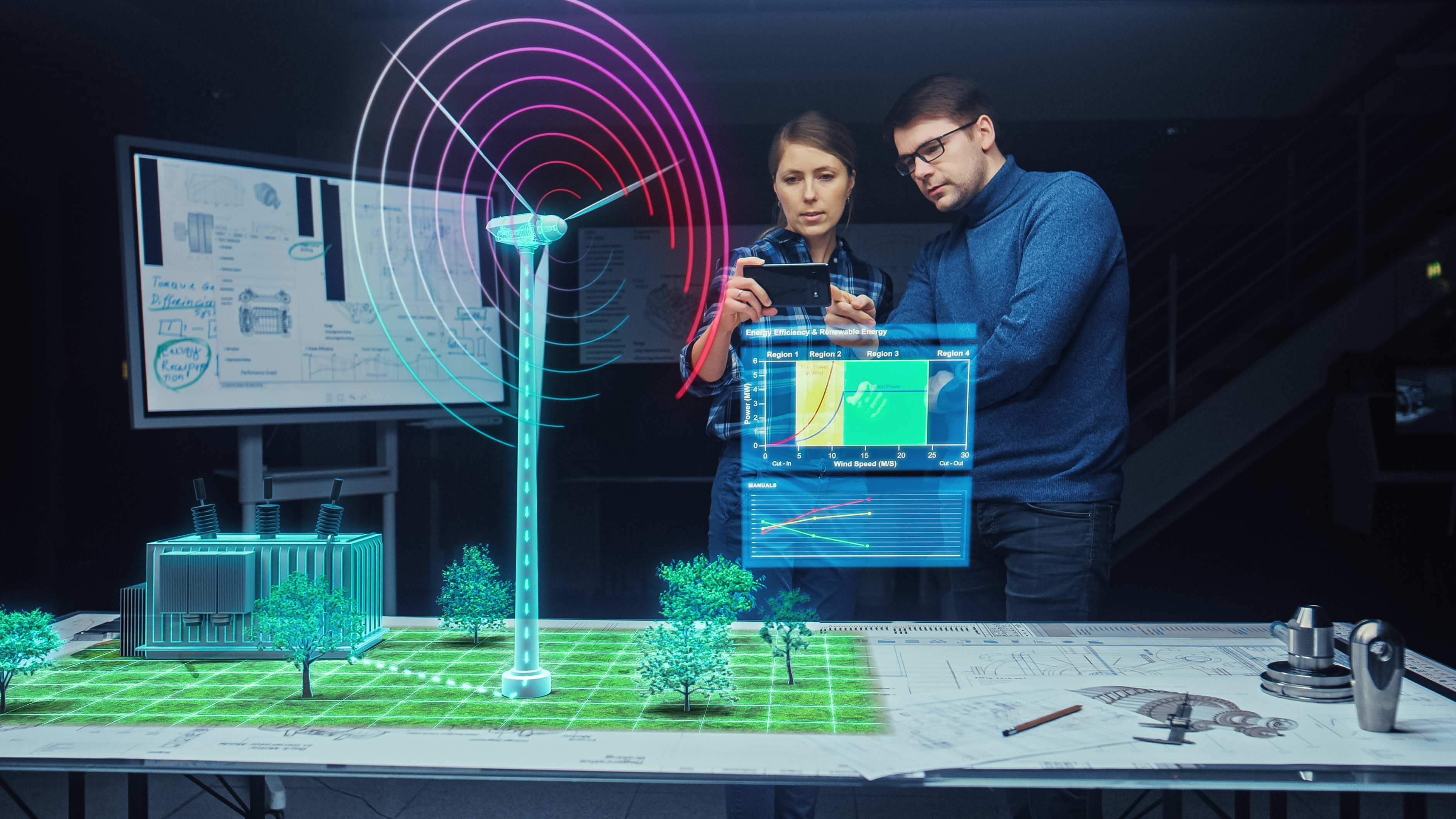
Renewable energy is an investment in our future. The use of digital technologies in this industry is one of the most important and sustainable trends in global development. It is estimated that information and communication technologies can enable a 20% reduction in global CO2e emissions by 2030, making it possible to balance economic prosperity with environmental protection.
Renewable energy software solutions harness technologies like big data, cloud computing, IoT, AI, and ML to collect, process, analyze, and manage data comprehensively. These integrated systems enhance efficiency and sustainability across various sectors.
If you’re committed to fostering a sustainable environment, you’ve come to the right place. In this blog post, we’ll delve into various types of sustainable energy software, highlight key features, and showcase a prototype of our own software designed for turbine management. Let’s get straight to the point.
Renewable Energy Software Trends
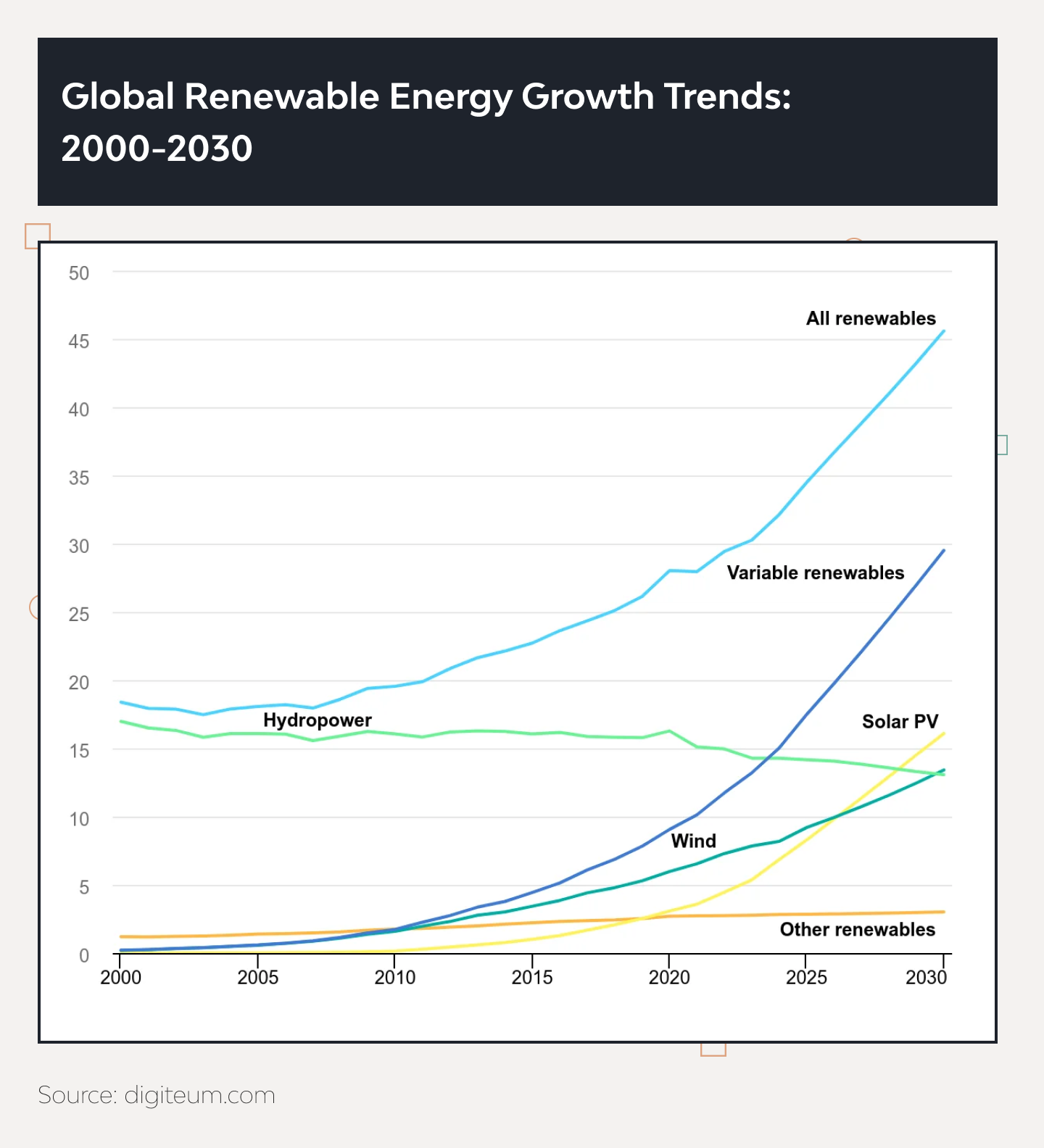
The renewable energy sector is rapidly evolving, driven by technological advancements and a global commitment to sustainability. Key trends such as improved battery storage, the emergence of hydrogen as a clean energy source, and advanced energy production monitoring are reshaping the energy landscape and boosting the renewable energy software market:
Battery Storage
Software solutions are enhancing battery energy storage systems (BESS) by improving efficiency, grid integration, and predictive maintenance. These tools enable real-time monitoring and AI-driven analytics, optimizing energy storage and distribution.
Hydrogen as a Clean Energy Source
Digital tools are crucial in managing hydrogen production and distribution. Software optimizes electrolysis processes and integrates hydrogen into existing energy systems, enhancing safety and efficiency.
Energy Production Monitoring
Advanced software enables real-time tracking and optimization of renewable energy generation. AI and IoT technologies provide predictive analytics, improving operational efficiency and grid stability.
Renewable Energy Software Trends Market Overview
The global renewable energy sector is expanding rapidly, with capacity expected to grow 2.7 times by 2030—surpassing current national targets by nearly 25%. This surge is driven by climate policies, energy security measures, and cost competitiveness, making renewables more attractive than fossil fuels. Private sector and household demand continues to rise, while government-backed industrial policies are boosting local production of solar panels and wind turbines.
Despite this progress, the ambitious goal set at the COP28 climate summit—to triple global renewable capacity—has yet to be fully realized.
Key Regional Growth Trends
- China is set to dominate, contributing 60% of the global capacity expansion by 2030.
- The European Union & the United States are on track to double their renewable capacity growth between 2024 and 2030.
- India is experiencing the fastest growth among major economies.
The Growing Renewable Energy Software Market
The demand for renewable energy software solutions is also accelerating. The global market, particularly in wind energy management, is expected to grow from $7.8 billion in 2024 to $20.2 billion by 2032, with a CAGR of 12.64% from 2025 to 2032. This growth is fueled by:
- Rising demand for energy management software
- Technological advancements in AI, IoT, and automation
- Government initiatives promoting sustainable energy adoption
Regional Market Leaders in Renewable Energy Software
- Europe leads the sector, driven by strict environmental regulations and strong software investments.
- North America follows, benefiting from supportive policies and increased awareness.
- Asia-Pacific, led by China and India, is rapidly expanding, investing in custom energy software and large-scale renewable projects.
The Future of Renewable Energy Software
As the industry shifts toward more efficient and intelligent infrastructure, renewable energy software solutions will play a critical role in optimizing power generation, enhancing operational efficiency, and accelerating the global transition to sustainable energy.
Key Challenges in Renewable Energy Software & How to Overcome Them
Developing renewable energy software solutions presents challenges like regulatory compliance, legacy system integration, and cybersecurity. However, the rising demand for advanced tools—such as smart grid solutions, predictive maintenance, and digital twins—offers forward-thinking companies significant opportunities to lead in the evolving energy sector. To navigate these complexities, we’ve outlined the primary challenges and their solutions:
Regulatory Barriers
One of the main hurdles in software for renewable energy is meeting diverse regulations across different countries. Energy standards and certification requirements vary significantly, making compliance complex.
Solution
- Implement modular software architecture to accommodate different regional regulations.
- Partner with legal experts to ensure compliance with local laws.
- Use international certification frameworks like IEC 61850 (for grid communication) and ISO 50001 (for energy management).
Integration with Outdated Energy Systems
Integrating modern renewable energy management software with legacy grid infrastructures presents significant challenges due to compatibility issues. Many existing energy grids were constructed long before the advent of contemporary sustainable technologies, leading to difficulties in seamless integration.
Solution
- Develop middleware and APIs to enable communication between old and new systems.
- Use IoT sensors and edge computing to enhance real-time data collection.
- Deploy AI-powered predictive maintenance tools to optimize aging infrastructure.
GridOS provides the modern software tools to orchestrate the complexity of the sustainable energy grid while driving reliability and resilience – even in the face of increasing security and weather threats.
Cybersecurity Risks
As renewable energy software solutions become more interconnected, they face heightened cybersecurity risks. The integration of digital technologies in the energy sector has expanded the attack surface, making power grids more susceptible to cyberattacks that could lead to large-scale blackouts.
Solution
- Implement multi-layered security, including encryption, zero-trust architectures, and network segmentation.
- Use AI-based threat detection to identify and mitigate cyber threats in real time.
- Regularly update software security patches and conduct penetration testing.
NVIDIA says that by integrating its platform and taking advantage of the AI-powered technology they are able to help customers bolster critical infrastructure such as energy, utilities and manufacturing facilities against cyber threats.
Big Data Processing Challenges
Processing vast datasets from solar panels, wind turbines, and smart grids is crucial for optimizing renewable energy production. Custom software solutions are essential to manage this data efficiently, enabling improved forecasting, real-time monitoring, and enhanced decision-making.
Solution:
- Utilize distributed cloud platforms like AWS for Energy for scalable storage and processing.
- Implement AI-driven analytics to improve energy forecasting.
- Use edge computing to process data locally before transferring it to the cloud.
Renewable energy software benefits
Before getting to the main features of green energy software, let’s dive deeper into the main benefits it brings to the table.
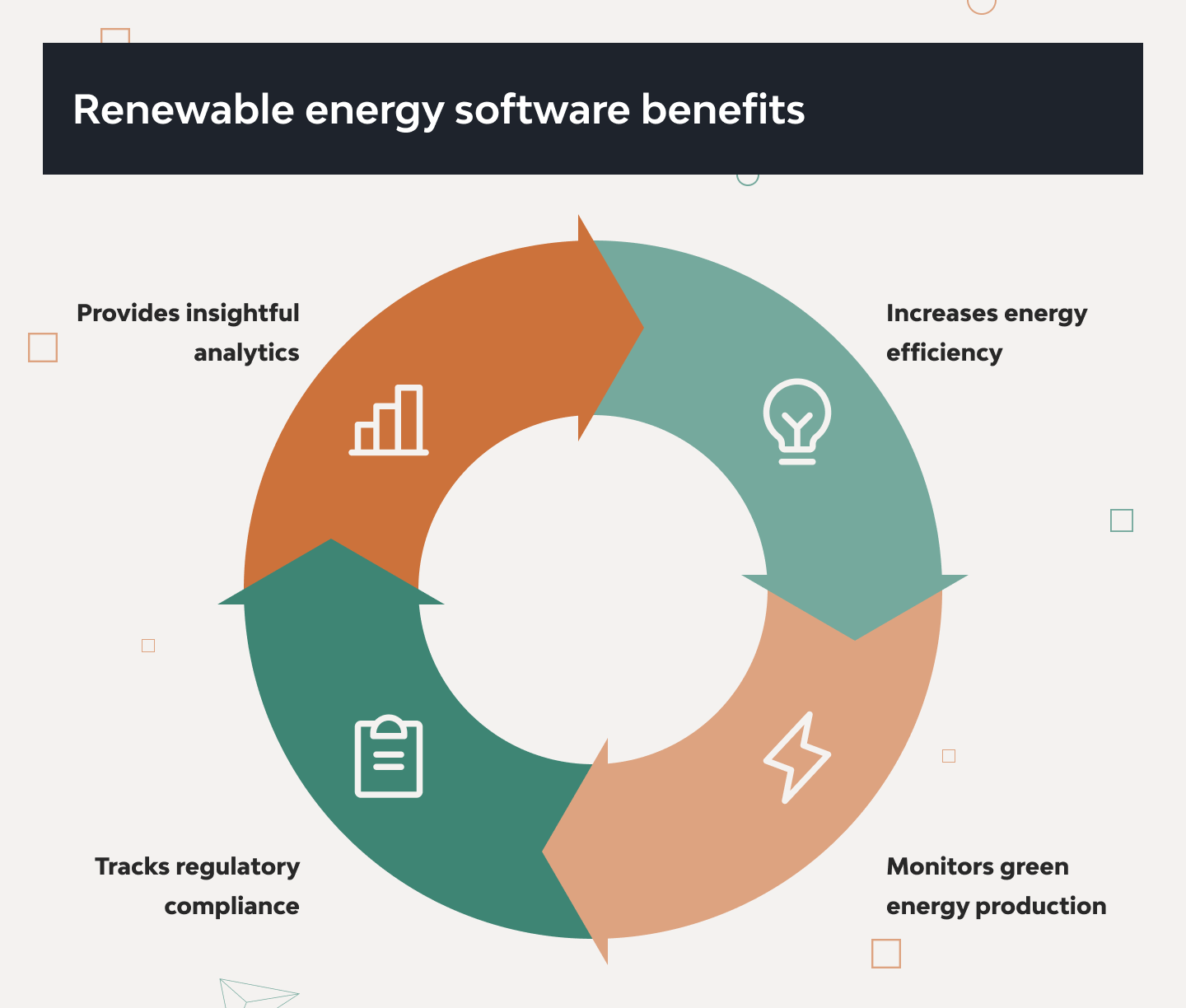
Increased energy efficiency and cost savings
By tracking energy consumption in real time, organizations can quickly spot any excessive energy use and optimize their operations accordingly. For example, they might use the energy during off-peak times when rates are lower.
Monitoring green energy production
Monitoring green energy production will help organizations analyze the efficiency of their renewable systems, get real-time data on renewable energy generation, and make the switch to renewable energy sources smoother.
Sustainability and regulatory compliance tracking
The software helps companies ensure regulatory compliance by tracking energy use and emissions. It also provides transparent reporting on energy consumption and carbon footprint, enhancing organizational sustainability.
Insightful analytics
Companies that have historical and real-time data at their fingertips will better analyze and track consumption patterns. As a result, they will optimize their renewable energy resources and distribute such energy sources as solar panels or batteries more efficiently.
Renewable energy software features
The functionality of renewable energy software varies based on its specific application. Key categories include carbon analytics and accounting tools, grid solutions for power companies, battery technology and storage systems, wind turbine and solar energy management software, and carbon capture and storage solutions. Each of these categories encompasses essential features tailored to address distinct challenges within the renewable energy sector.
| Feature | Primary Users | Business Effect | Application Areas |
| Centralized Energy Monitoring Dashboard | Energy managers, facility operators, sustainability and compliance officers, executives, utility providers, manufacturing plants, commercial real estate firms. | It provides a real-time view of energy use, storage, costs, and anomalies, enabling energy managers, facility operators, and sustainability officers to make informed decisions. The dashboard also supports predictive maintenance and advanced analytics, which help reduce downtime and improve operational efficiency. | Companies use these dashboards to monitor and manage energy usage across multiple facilities. It allows organizations to track energy goals, optimize resource allocation, and ensure compliance with environmental standards. |
| Utility Tracking | CFOs, procurement teams, energy auditors | It enhances financial performance by identifying cost-saving opportunities and improving resource management. It enables organizations to monitor energy consumption, detect anomalies, and optimize usage, leading to reduced operational costs and increased efficiency. | Utility tracking enables manufacturing plants, commercial real estate firms, and renewable energy providers to benchmark facilities, optimize energy consumption, and lower operational expenses. This leads to enhanced financial performance and more efficient resource management. |
| Detailed Reporting | Compliance officers, sustainability consultants, executives. | The feature enhances transparency and ensures regulatory compliance, leading to improved stakeholder trust. By providing comprehensive insights into energy consumption and emissions, it enables organizations to optimize operations and achieve cost savings. | Energy companies, government agencies, and corporations with ESG commitments depend on detailed reporting to monitor performance and communicate outcomes to stakeholders. This practice enhances transparency, ensures regulatory compliance, and fosters improved stakeholder trust. |
| Predictive Maintenance and Troubleshooting | Maintenance teams, operations managers, engineers. | Utilizing AI and forecasting algorithms, this feature predicts equipment failures and optimizes maintenance schedules. By identifying potential issues before they lead to downtime, companies can reduce maintenance costs and extend asset lifespans. | Wind farms, solar plants, and battery storage facilities increasingly implement predictive maintenance to enhance reliability and minimize disruptions. This approach boosts operational efficiency, reduces downtime, and lowers maintenance costs. |
Renewable Energy Software Development for Different Sectors
The renewable energy sector encompasses diverse sources, each facing unique challenges—from resource variability to grid integration—that require specialized software. As demand for these solutions grows, their development becomes essential to optimize performance and drive innovation across all facets of the renewable energy landscape. Let’s explore renewable energy software development across different sectors.
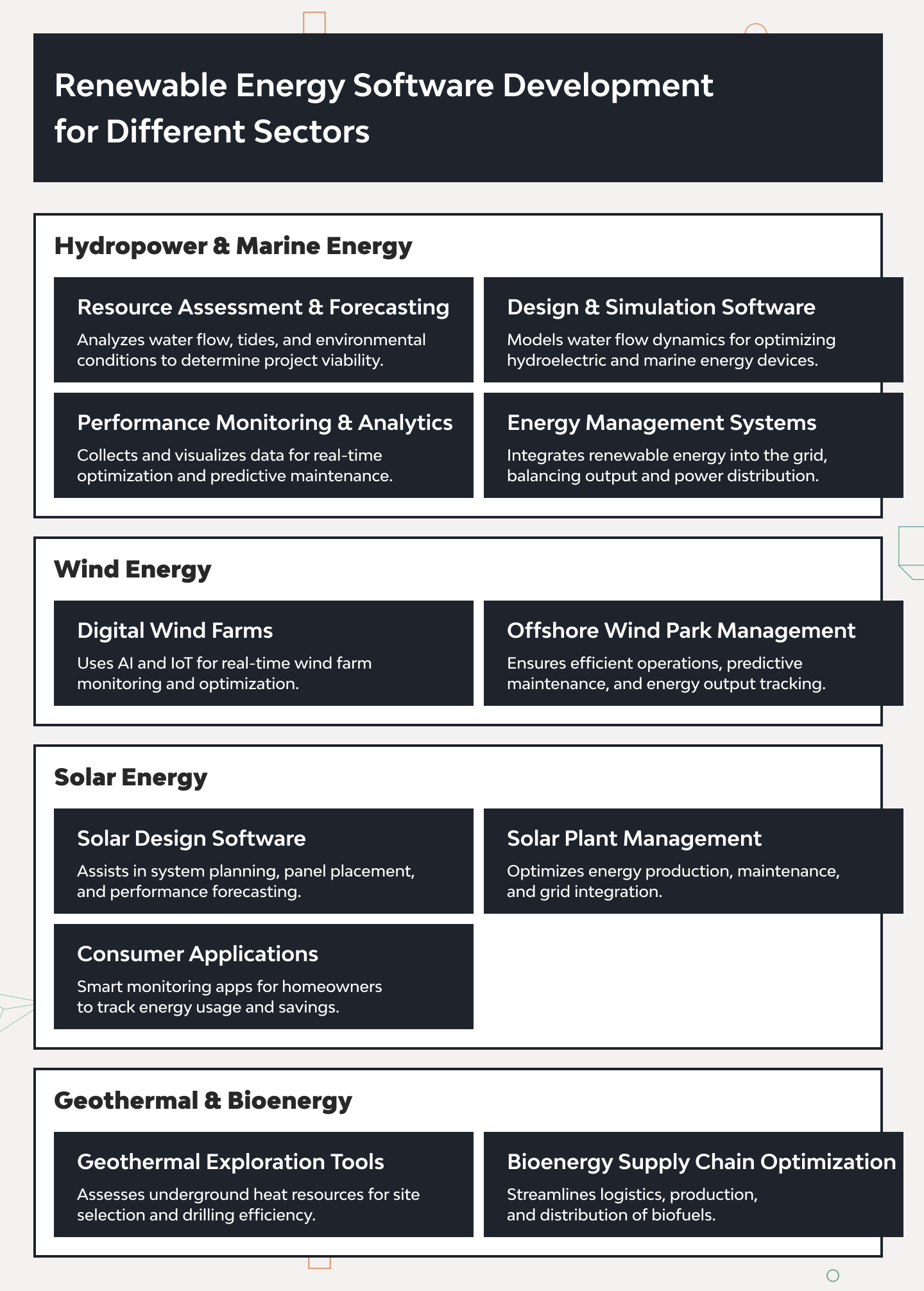
Hydroelectric Power Software
Hydroelectric power relies on the efficient management of water flow, turbine performance, and dam operations. One of the most critical types of software for hydroelectric power is dam and reservoir management systems. These tools track water levels, flow rates, and sediment buildup to maximize energy output while maintaining ecological balance.
The large infrastructure of hydropower plants requires real-time performance and machinery health monitoring, asset management, and predictive maintenance for new and aging assets. All-in-one platform GE’s Hydro APM based on IIoT and data analytics technologies is a great example. This multi-feature solution provides hydropower operators with monitoring, analytics and modeling tools to help them maximize performance, cut costs, and improve security at the plants.
Wind Energy Software
The software focuses on enhancing turbine performance, optimizing farm layouts, and integrating wind-generated power into energy grids. Wind farm design tools are essential for determining the optimal placement of turbines to maximize efficiency. For instance, Vestas’ Envisage uses AI to design wind farms tailored to site-specific conditions, ensuring the highest possible energy output.
Another essential type of software in the renewable energy sector is a turbine performance monitoring tool that tracks real-time data on output, vibrations, and wear, enabling operators to detect issues early and schedule maintenance proactively. Simultaneously, grid integration platforms manage fluctuations in energy supply, ensuring stable incorporation of wind power into existing networks. Together, these technologies enhance the reliability and efficiency of wind energy production.
These solutions are widely adopted by companies like Ørsted and NextEra Energy, which operate both offshore and onshore wind farms.
Solar Energy Software
Solar energy software encompasses the entire lifecycle of photovoltaic systems, from design and installation to monitoring and storage management. These tools assist in creating efficient system layouts, overseeing performance, and optimizing energy storage solutions. Aurora Solar, for instance, enables installers to design rooftop systems using LiDAR and satellite data, ensuring optimal efficiency. Once operational, monitoring platforms track real-time energy generation and panel health. SolarEdge’s Monitoring Platform provides detailed insights into system efficiency and sends alerts for maintenance, helping operators maximize energy production.
Another key area is energy storage optimization, which manages battery storage to balance supply and demand. Tesla’s Autobidder exemplifies this by autonomously managing battery assets, enabling real-time energy trading to maximize revenue and enhance grid stability.
These tools are widely utilized by large-scale photovoltaic installations, such as Solar Star in California, and companies like SunPower, enabling them to deliver reliable and efficient solar energy solutions.
Software for Solar Power (Advanced Applications)
Beyond basic monitoring and design, advanced solar software addresses emerging challenges such as grid resilience, decentralized energy systems, and hybrid energy projects. One such application is microgrid management systems, which are essential for controlling solar-powered microgrids in remote or off-grid areas. Schneider Electric’s EcoStruxure Microgrid Advisor is a leading solution, optimizing solar-diesel-battery hybrid systems to ensure reliable energy supply.
Another innovative category is community energy platforms, which manage shared solar projects for residential and commercial users. PowerMarket offers a SaaS tool for managing shared solar subscriptions, making renewable energy accessible to a broader audience. Additionally, AI-driven forecasting solutions, such as IBM’s Renewables Forecasting, use ML to predict solar generation based on weather patterns and historical data, improving grid stability and energy planning.
Utilities like Duke Energy and innovators such as LO3 Energy are deploying advanced solutions to expand the reach of solar power.
Renewable Energy Software Tech Stack
The clean energy industry increasingly relies on advanced technologies like Artificial Intelligence (AI), the Internet of Things (IoT), Machine Learning (ML), and Digital Twins to enhance energy generation, efficiency, and data-driven decision-making. These innovations form the backbone of modern renewable energy software, enabling organizations to monitor consumption, predict demand, and analyze vast datasets effectively. Let’s investigate each of these technologies further:
Artificial Intelligence (AI)
It’s revolutionizing the renewable energy sector by enabling predictive analytics, automation, and optimization. One prominent application is in forecasting energy generation, where the technology algorithms analyze weather patterns, historical data, and grid demand to predict outputs from solar and wind sources, aiding in effective supply and demand balancing. Additionally, AI examines consumption patterns to optimize usage and reduce waste. Enhanced weather forecasting through AI further refines energy production planning, contributing to grid stability and efficiency.
A groundbreaking example of AI’s application in sustainability is the AI Energy Score, developed by Salesforce. This first-of-its-kind benchmarking tool allows users to evaluate, identify, and compare the energy consumption of AI models. Addressing the lack of transparency around the environmental impact of these models, the company introduces a standardized framework for measuring and comparing energy efficiency. It features a public leaderboard showcasing scores for 166 models across 10 common tasks and a benchmarking portal where developers can submit their models for evaluation. Recognized by the French Government and the Paris Peace Forum for its transformative potential, this initiative aims to drive sustainable AI development.
Internet of Things (IoT)
IoT technology connects physical devices to the digital world, enabling continuous monitoring and control of renewable energy systems. A key application is remote monitoring, where sensors track energy flow, equipment performance, and environmental conditions in real-time. This data is transmitted to centralized platforms, allowing operators to make informed decisions and respond swiftly to issues. Additionally, IoT facilitates the creation of Digital Twins—virtual replicas of physical assets like wind turbines and solar panels. These Digital Twins offer insights into asset performance and enable predictive maintenance.
Cisco Industrial IoT is extensively utilized in the production and monitoring of renewable energy. Their solutions facilitate the integration of solar and wind farms into smart grids, ensuring efficient energy distribution and management. Cisco’s IoT platforms also support predictive maintenance by collecting and analyzing data from sensors embedded in renewable energy equipment, helping operators identify potential issues before they lead to downtime.
Machine Learning
ML is pivotal in analyzing extensive datasets to identify patterns, make predictions, and optimize renewable energy systems. In solar and wind power generation, the technology algorithms utilize weather forecasts and historical data to accurately predict energy output, aiding providers in managing supply and demand fluctuations. Additionally, ML assists in site selection by evaluating environmental data to pinpoint optimal locations for renewable projects. It also forecasts energy demand based on historical consumption and weather conditions, enabling utilities to enhance grid operations.
PowerScouts, a California-based firm, utilizes ML to analyze over 100 billion data points, identifying households likely to adopt solar energy. This approach enables targeted marketing, increasing the efficiency of customer acquisition. UrbanChain operates a green energy marketplace that employs ML and distributed ledger technology to directly connect renewable energy producers with consumers, bypassing traditional power companies. This model has facilitated significant growth, with annual sales reaching £25 million last year.
Digital Twins
These are virtual replicas of physical assets that enable continuous observation, simulation, and enhancement. In renewable energy, they monitor equipment like wind turbines and solar panels, offering immediate insights into performance. By simulating equipment behavior, Digital Twins facilitate predictive maintenance, identifying potential issues before they lead to failures. Additionally, they allow operators to test various scenarios, optimizing energy production and grid integration.
With their help, GE Renewable Energy optimizes turbine designs and improves wind farm efficiency. Their digital twin technology builds on AI-driven simulations, initially applied to gas turbines, which minimize emissions and electrical noise by finding the optimal flame temperatures and fuel splits.
Case Study: Prototype Management Platform for Wind Farms and Solar Parks by DjangoStars
To illustrate the potential of renewable energy software, DjangoStars developed a prototype management platform designed to optimize wind farms and solar parks. This real-time system enables organizations to monitor, analyze, and manage energy production efficiently. Operators can track wind and solar plants through a remote data collection system, allowing immediate response to malfunctions and improved operational performance.
The platform integrates several core features, each addressing specific operational needs:
Performance Monitoring
Task: Improve real-time tracking of critical asset parameters to enhance operational efficiency.
What Was Done: The platform was equipped with sensors and data collection tools to monitor essential metrics such as wind speed, rotor speed, temperature, and power output. Data from turbines and solar panels was synchronized with a central server for real-time access and long-term storage. A maintenance tracking system was also integrated to monitor asset health and ensure timely repairs.
Results: Operators gained instant visibility into equipment conditions, enabling faster response times, improved efficiency, and reduced downtime. The centralized system streamlined maintenance planning and helped prevent unexpected failures, optimizing overall energy production.
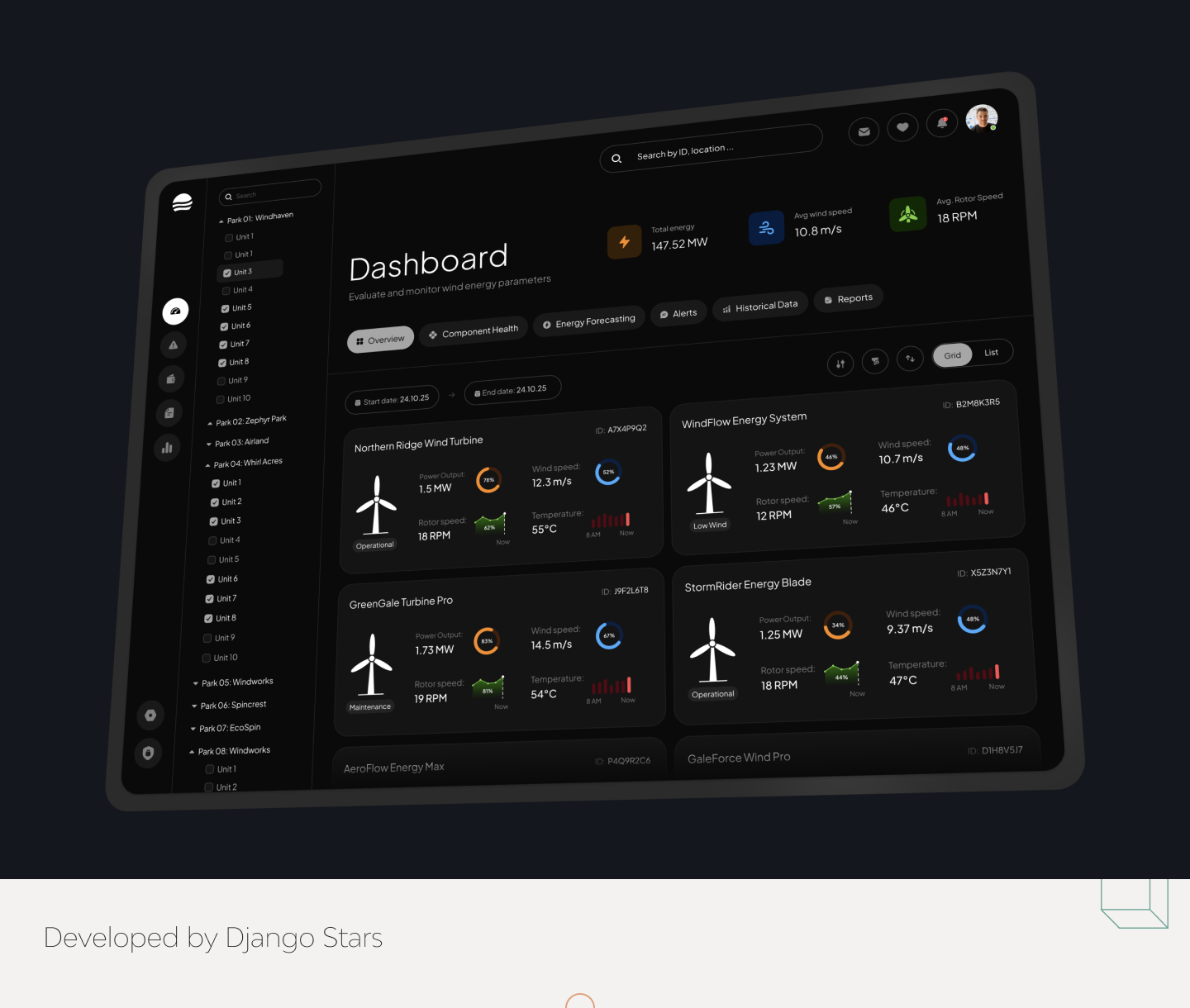
Troubleshooting
Task: Reduce downtime and prevent equipment failures using predictive analytics.
What Was Done: Each asset was integrated with sensors connected to the software. Advanced machine learning algorithms and predictive analytics were applied to detect potential malfunctions before they occurred. Operators received real-time maintenance alerts when irregularities were detected, allowing them to act preemptively.
Results: The platform significantly reduced unplanned outages and costly repairs, improving system reliability. Operators could now predict maintenance needs, leading to longer equipment lifespans and optimized maintenance scheduling.
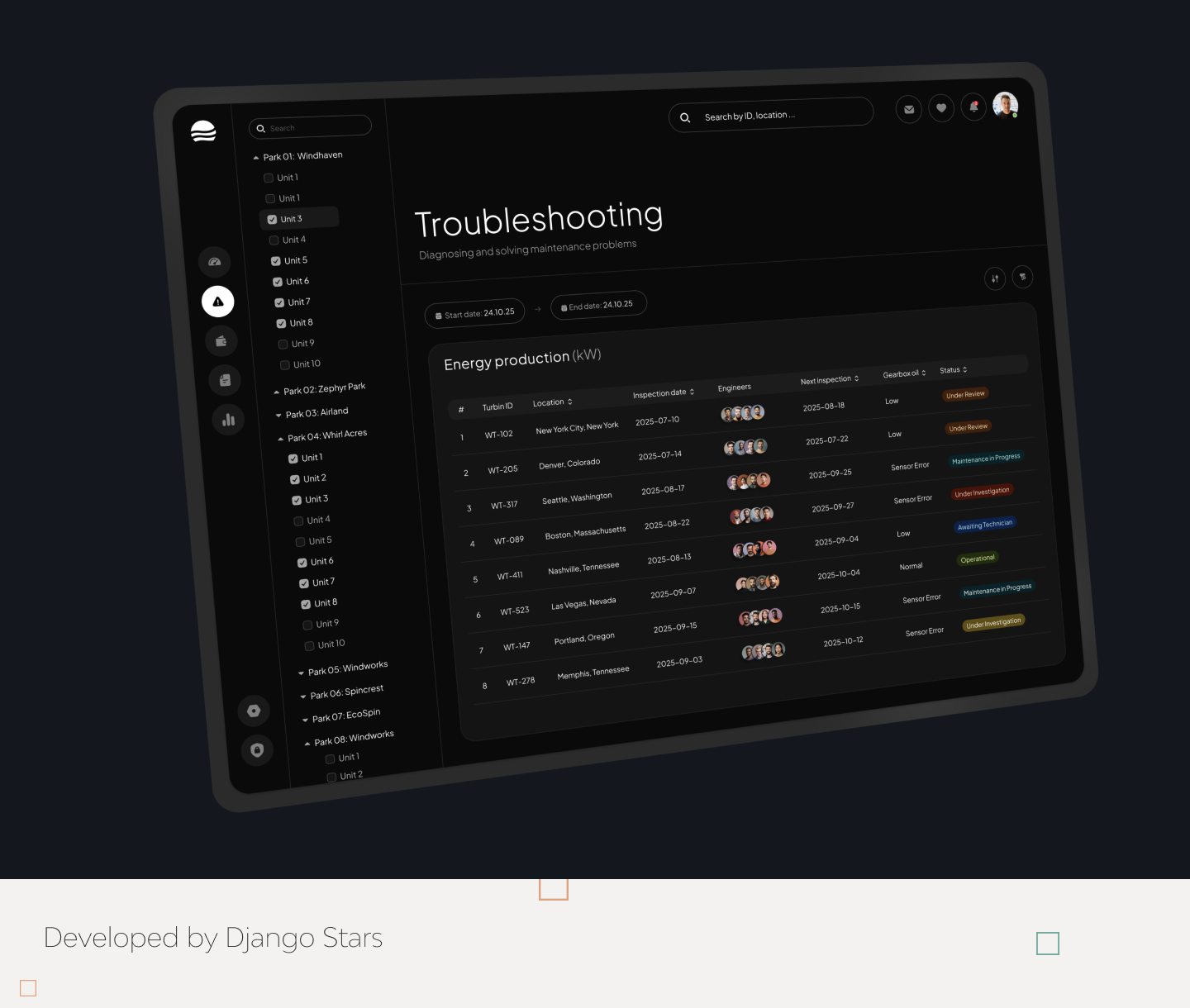
Budget Management
Task: Help organizations control operational costs and optimize energy expenses.
What Was Done: A budget management dashboard was developed to track energy costs, calculate ROI, identify inefficiencies, and optimize financial planning. The system provided a detailed breakdown of expenses related to maintenance, production, and operational activities, enabling data-driven decision-making.
Results: Companies using the platform experienced better financial control, enabling them to identify cost-saving opportunities and allocate resources more effectively. With clear insights into spending patterns, they could optimize operations while reducing unnecessary costs.
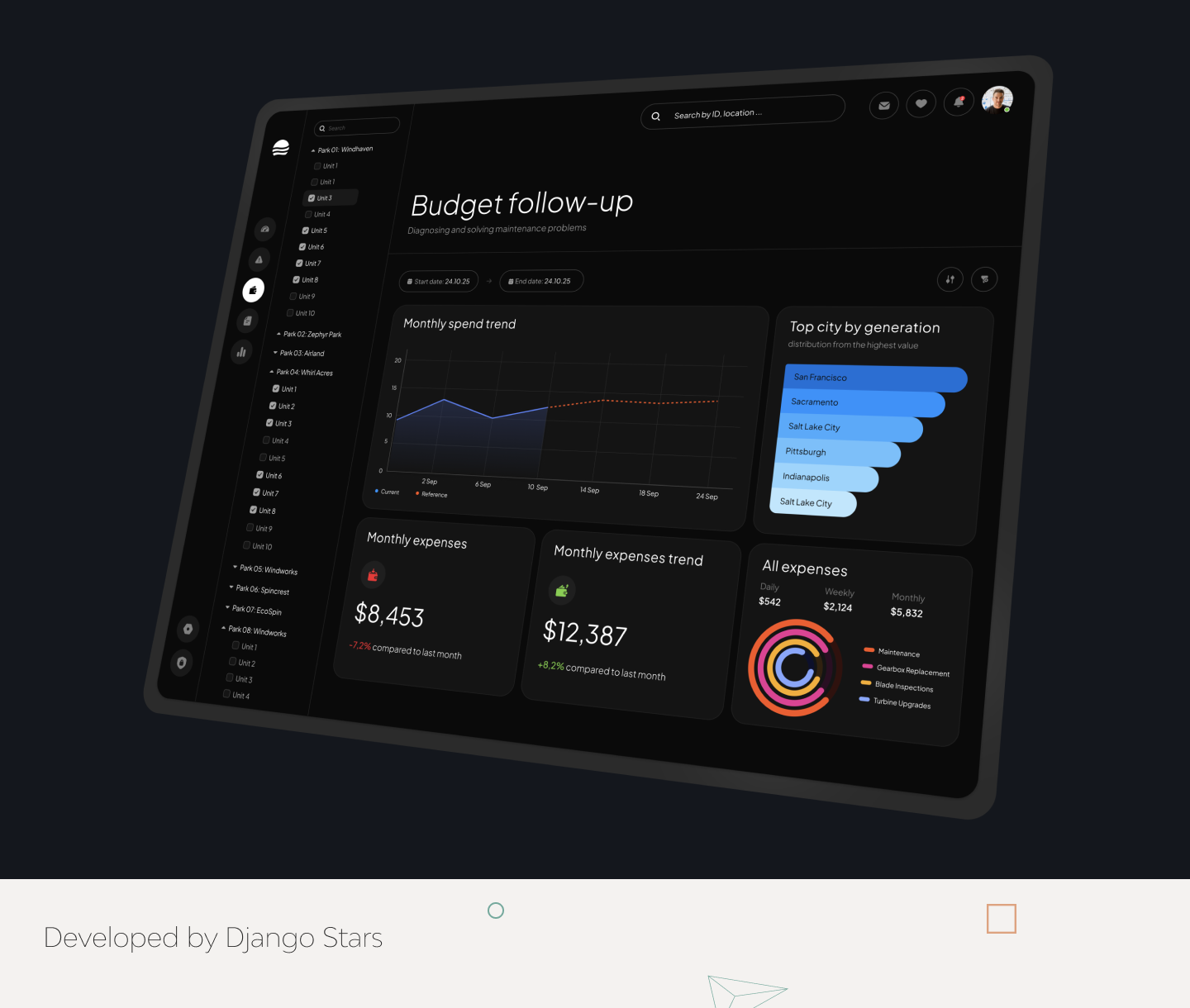
The budget management dashboard helps track energy expenses, calculate ROI, find any bottlenecks in budget planning, and optimize spending accordingly.
Reporting and data
With a reporting dashboard, companies can track their energy production as well as monitor energy generation trends.
Renewable Energy Software Tech Stack
Renewable energy solutions usually combine AI, machine learning, blockchain, and IoT to help organizations monitor energy consumption, make predictions, and analyze large amounts of data.
Artificial intelligence use cases
Here are the most common use cases of AI in renewable energy systems:
- Renewable energy generation forecast
- Analysis of energy consumption patterns to predict demand
- Energy consumption analytics
- Weather forecasting for more efficient energy production
IoT use cases
- Digital twinning of solar panels and wind turbines to monitor energy production in real-time
- Remote monitoring of energy flow with the help of sensors and wind turbine monitoring system
Machine learning use cases
- Solar and wind power output prediction based on weather forecasts
- Analysis of the environmental data to identify locations for renewable energy production
- Analysis of the historical consumption data, weather conditions, and other factors to predict demand
These are the general use cases, and the choice of the technology will depend on your software type, business requirements, features, and project size.
Conclusion
Now is an ideal time to invest in renewable energy software development. Despite a slight decline in overall sector funding, certain industries continue to attract significant capital. For instance, global investment in clean energy technologies and infrastructure is projected to reach $2 trillion in 2024, nearly double the amount allocated to fossil fuels.
If you’re considering entering the renewable energy market and require technical consultation, we’re here to assist. Our team will assess your business needs and develop a tailored product development strategy. Contact us for a technical consultation, and let’s protect the environment together.




